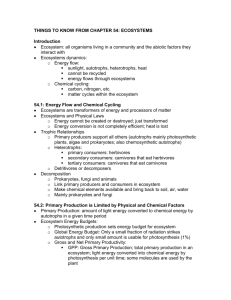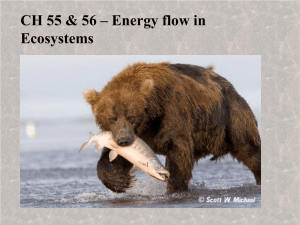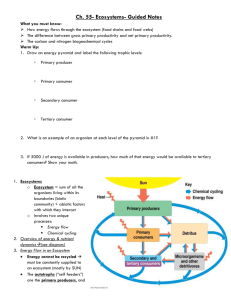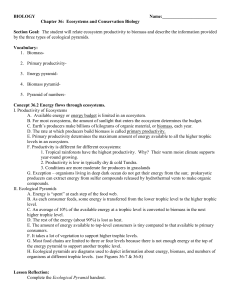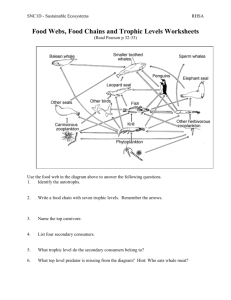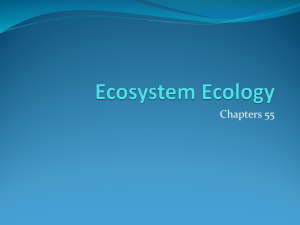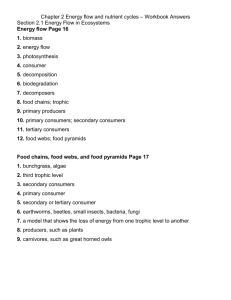File
advertisement
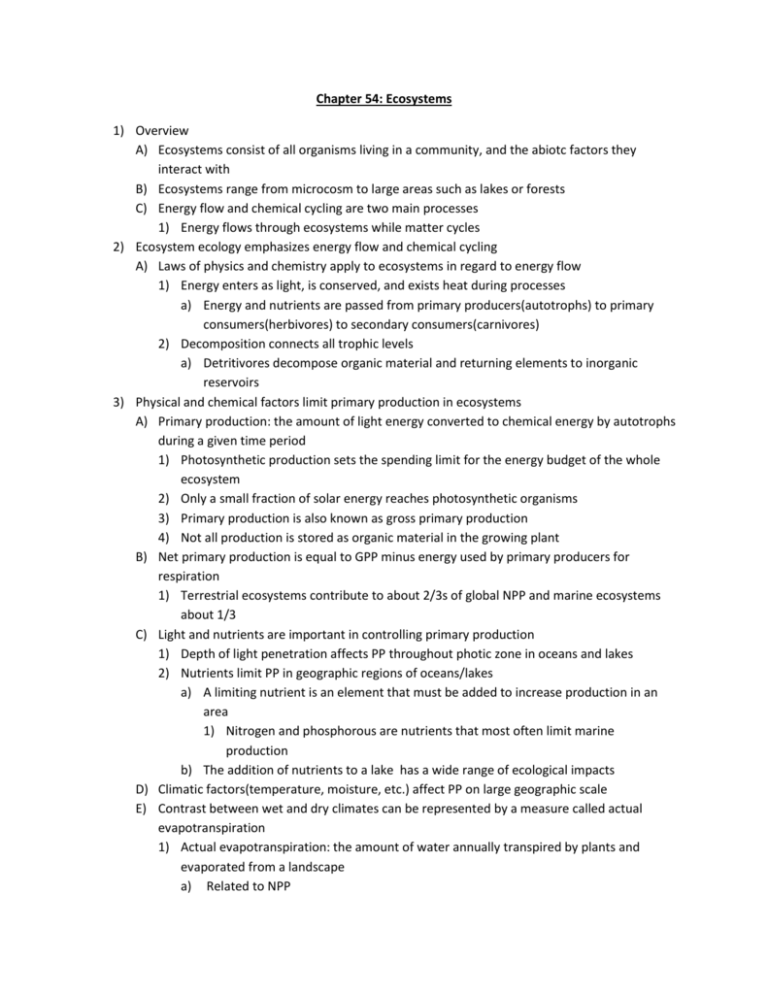
Chapter 54: Ecosystems 1) Overview A) Ecosystems consist of all organisms living in a community, and the abiotc factors they interact with B) Ecosystems range from microcosm to large areas such as lakes or forests C) Energy flow and chemical cycling are two main processes 1) Energy flows through ecosystems while matter cycles 2) Ecosystem ecology emphasizes energy flow and chemical cycling A) Laws of physics and chemistry apply to ecosystems in regard to energy flow 1) Energy enters as light, is conserved, and exists heat during processes a) Energy and nutrients are passed from primary producers(autotrophs) to primary consumers(herbivores) to secondary consumers(carnivores) 2) Decomposition connects all trophic levels a) Detritivores decompose organic material and returning elements to inorganic reservoirs 3) Physical and chemical factors limit primary production in ecosystems A) Primary production: the amount of light energy converted to chemical energy by autotrophs during a given time period 1) Photosynthetic production sets the spending limit for the energy budget of the whole ecosystem 2) Only a small fraction of solar energy reaches photosynthetic organisms 3) Primary production is also known as gross primary production 4) Not all production is stored as organic material in the growing plant B) Net primary production is equal to GPP minus energy used by primary producers for respiration 1) Terrestrial ecosystems contribute to about 2/3s of global NPP and marine ecosystems about 1/3 C) Light and nutrients are important in controlling primary production 1) Depth of light penetration affects PP throughout photic zone in oceans and lakes 2) Nutrients limit PP in geographic regions of oceans/lakes a) A limiting nutrient is an element that must be added to increase production in an area 1) Nitrogen and phosphorous are nutrients that most often limit marine production b) The addition of nutrients to a lake has a wide range of ecological impacts D) Climatic factors(temperature, moisture, etc.) affect PP on large geographic scale E) Contrast between wet and dry climates can be represented by a measure called actual evapotranspiration 1) Actual evapotranspiration: the amount of water annually transpired by plants and evaporated from a landscape a) Related to NPP F) Soil nutrient is often the limiting factor in PP on a local scale 4) Energy transfer between trophic levels is usually less than 20% efficient A) Secondary production of an ecosystem is the amount of chemical energy in consumers’ food that is converted to their own new biomass during a given period of time B) Production efficiency of an organism is the fraction of energy stored in food that is not used for respiration C) Trophic efficiency is the percentage of production transferred from one trophic level to the next, ranges from about 5% to 20% 1) Loss of energy with each transfer in a food chain is represented by a pyramid of net production 2) Ecological consequences of low trophic efficiencies are represented in a biomass pyramid a) Biomass pyramid usually show a decrease at successively higher trophic levels b) Certain aquatic ecosystems have inverted biomass pyramids c) Pyramid of numbers represents the number of individual organisms in each trophic level D) Energy flow though ecosystems have important implications for the human population 1) Eating meant is relatively inefficient way of tapping PP a) More people could be fed if all humans ate only plant material, causing them to be more efficient b) Green World Hypothesis: Terrestrial herbivores consume relatively little plant biomass because they are held in check by a variety of factors 1) Plants have defenses against herbivores 2) Nutrients, not energy supply, usually limit herbivores 3) Abiotc factors limit herbivores 4) Intaspecific competition can limit herbivore numbers 5) Interspecific interactions check herbivore densities 5) Biological and geochemical processes move nutrients between organic and inorganic parts of the ecosystem A) Life on Earth depends on the recycling of essential chemical elements 1) Gaseous forms of carbon, oxygen, sulfur, and nitrogen occur in the atmosphere and cycle globally 2) Less mobile elements include phosphorous, potassium, and calcium which cycle on a more local level B) Nutrient circuits that cycle matter through an ecosystem involve both biotic and abiotic components and are often called biogeochemical cycles C) All elements cycle between organic and inorganic reservoirs D) Biogeochemical cycles: 1) Water cycle a) Global cycle driven by solar energy 2) Carbon cycle a) Reflects the reciprocal processes of photosynthesis and cellular respiration 3) Nitrogen cycle a) Involves local cycles between organisms and soil or water 4) Phosphorous cycle a) Is relatively localized E) Decomposers play a key role in the general pattern of chemical cycling 1) Rates of nutrient cycles differ due to differences in the rate of decomposition F) Nutrient cycling is regulated by vegetation 6) The human population is disrupting chemical cycles throughout the biosphere A) As the population grows, our activities disrupt the trophic structure/energy flow/chemical cycling of ecosystems B) We not only transport nutrients, but add new materials, some toxins, into ecosystems 1) Agriculture removes nutrients from ecosystems that would normally be cycled back into the soil a) Nitrogen is the main nutrient lost in agriculture, so it has a huge impact on the nitrogen cycle 1) Industrial fertilizer is used to replace nitrogen, but it can be harmful to ecosystems C) The critical load for a nutrient is the amount of that nutrient that can be absorbed by plants in an ecosystem without damaging it 1) When critical load is exceeded, the remaining nutrients can contaminate groundwater and freshwater and marine ecosystems 2) Sewage runoff contaminates freshwater ecosystems causing significant harm to the ecosystems D) Combustion of fossil fuels causes acid precipitation 1) North American and European ecosystems have been damaged by rain/snow containing nitric and sulfuric acid 2) Regulations and technologies have helped many developed counties to reduce sulfur dioxide emissions E) Humans release toxic chemicals including synthetics unknown to nature 1) Toxins are extremely harmful because they become more concentrated in successive trophic levels of a food web a) Biological magnification causes toxins to concentrate at higher trophic levels because of the lower biomass F) Rising levels of carbon dioxide 1) Increased burning of fossil fuels and other human activities 2) Greenhouse effect is cause by carbon dioxide, but is necessary to keep the surface of the Earth at a habitable temperature a) Increase in carbon dioxide magnifies greenhouse effect causing global warming G) Ozone molecules present in the atmosphere protect life on Earth from UV radiation from the sun 1) Layer is thinning since 1975 2) Destruction results from chlorine-releasing pollutants produced by human activity

